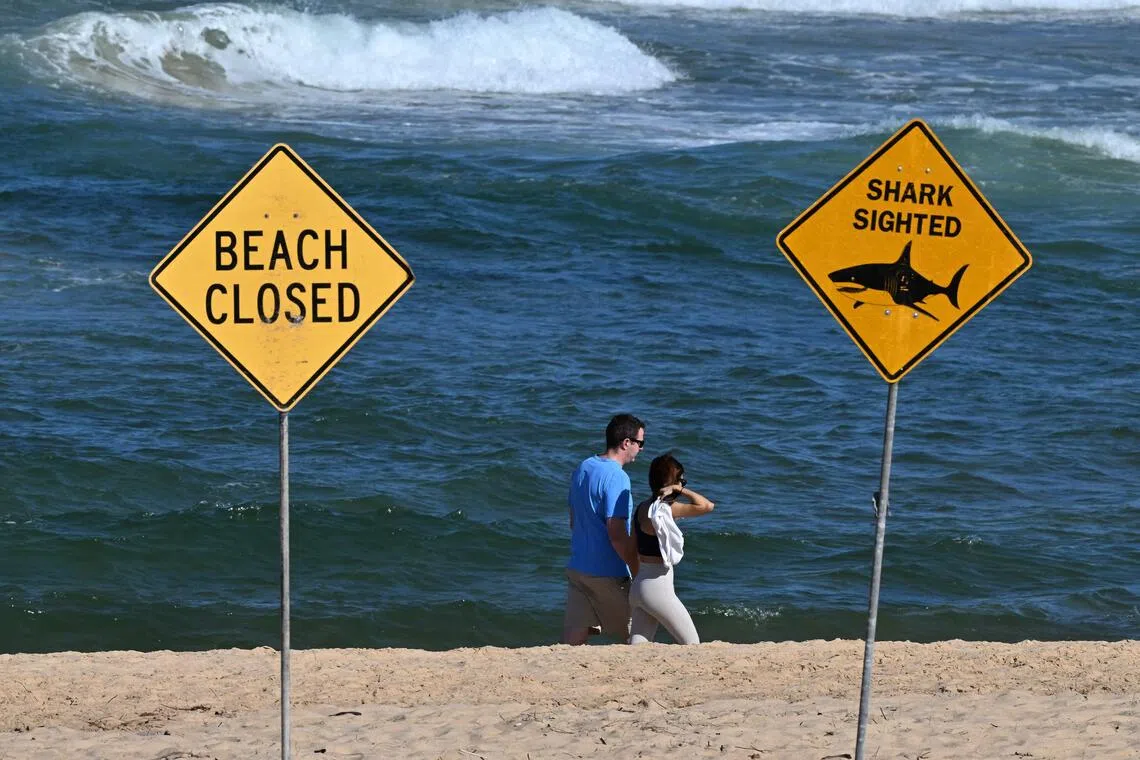Woman killed, man injured in bull shark attack off Australia’s east coast
Sign up now: Get ST's newsletters delivered to your inbox

Beach closure and shark warning signs at Long Reef Beach in Australia after a suspected shark attack in September.
PHOTO: AFP
Follow topic:
SYDNEY – A bull shark killed a woman swimming off a remote beach in Australia’s eastern state of New South Wales (NSW) on Nov 27, while a man was seriously injured and may have been saved by the “heroic” efforts of a passer-by.
The woman died at the scene of the attack, which took place in the early hours of the morning in the remote Crowdy Bay, around 250km north of Sydney.
The man had serious leg injuries and was airlifted to hospital. Police have said his condition is stable.
“They were known to each other, and they were going for a swim and the shark attacked,” New South Wales Police Inspector Timothy Bayly told reporters.
A passer-by potentially saved the man’s life by wrapping a makeshift tourniquet around his leg, state Ambulance Inspector Joshua Smyth said.
He said that the courage of some people was “amazing in this situation – to put yourself out there is very heroic”.
Mr Steven Pearce, Surf Life Saving NSW chief executive, described it as “a really, really terrible incident”.
“This area is so remote, there’s no lifeguarding services up there at all,” he told local radio station 2GB.
Emergency services were called at around 6.30am to the site of the attack.
The authorities determined that a bull shark – one of the deadliest species of the deep-sea predatory fish – was most “likely to have been” involved in the attack.
Assessments are usually made by examining bite marks, animal behaviour, any recent sightings or ocean conditions leading up to the incident.
Bull sharks are the only species of the cartilaginous fish that can move between fresh and salt water, allowing them to swim vast distances.
They can grow up to 2.3m long and are among the species of shark most likely to bite ocean-goers in Australia, alongside the great white and tiger sharks.
Attacks on the rise
There have been more than 1,280 shark incidents around Australia since 1791, of which over 250 resulted in death, according to a database of the predators’ encounters with humans.
Of the total number of recorded incidents since records began, 212 involved bull sharks.
Increasingly crowded waters and rising ocean temperatures that appear to be swaying sharks’ migratory patterns may be contributing to an escalation in attacks despite overfishing depleting some species, scientists say.
In September, a great white shark mauled a surfer to death at a popular Sydney beach.
The man, who left a wife and young daughter, lost “a number of limbs” and his surfboard was broken in two, police said.
Australia’s oceans are teeming with sharks, with great whites topping the list of species that might fatally chomp a human.
Though still relatively rare, fatal attacks do appear to be on the rise, with 56 reported deaths in the 25 years to 2025, compared with 27 deaths in the previous quarter-century.
Undeterred, Australians flock to the sea in huge numbers. A 2024 survey showed that nearly two-thirds of the population made a total of 650 million coastal visits in a single year.
How best to protect people from sharks is a sensitive topic in Australia.
The authorities have adopted a multi-layered approach – deploying drones, fixing acoustic trackers to sharks so they can be detected by listening buoys near popular beaches, alerting people in real time with a mobile app and stringing up old-fashioned nets.
Researchers say shark lives, too, need protecting.
Globally, about 37 per cent of oceanic shark and ray species are now listed as either endangered or critically endangered by the International Union for Conservation of Nature, a database for threatened species. AFP

